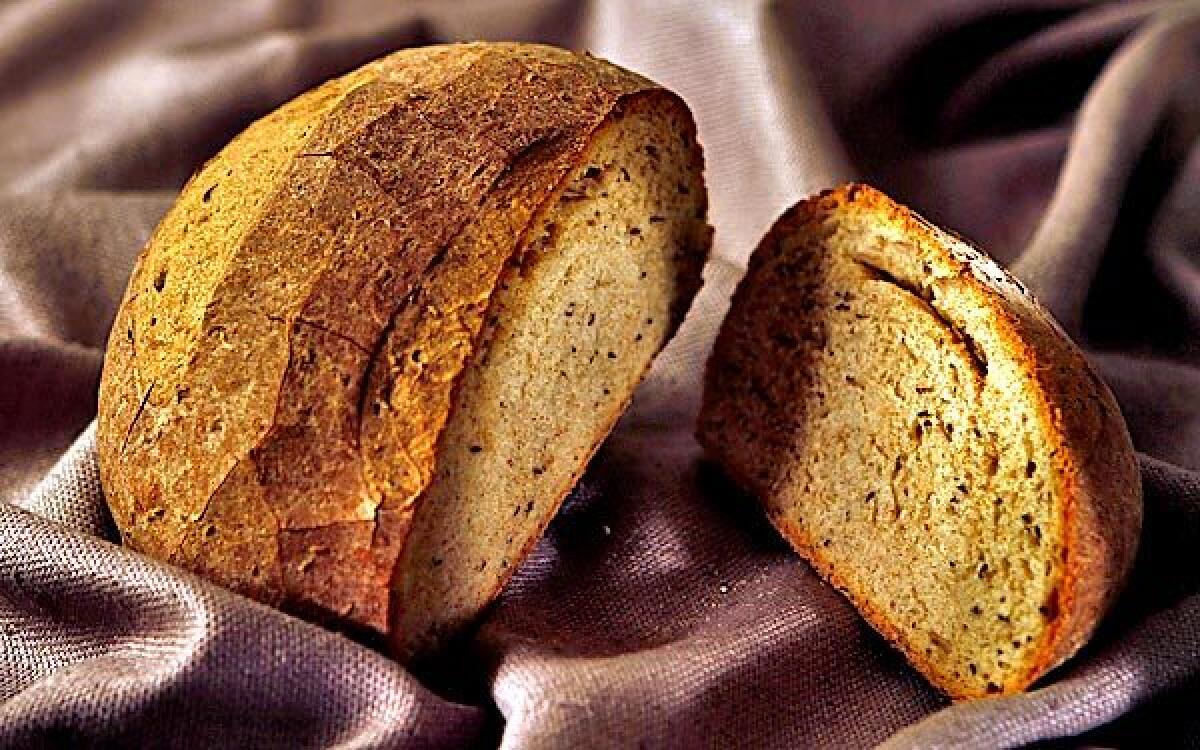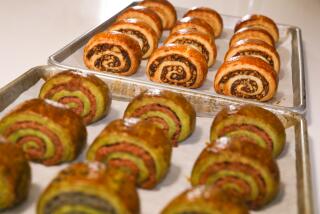Recipe: Real Jewish rye bread

- Share via
Real Jewish rye bread
Total time: 1 hour, 10 minutes, plus rising and cooling times
Servings: Makes 1 round loaf (8 to 12 servings)
Note: Adapted from “The Bread Bible” by Rose Levy Beranbaum. Specialty flours and barley malt syrup are available at select well-stocked markets, health food, cooking and baking supply stores, as well as online.
Sponge (dough starter)
3/4 cup (4 ounces) bread flour
3/4 cup (3.3 ounces) rye flour
1/2 teaspoon (0.06 ounce) instant yeast
1 1/2 tablespoons (0.6 ounce) sugar
1/2 tablespoon barley malt syrup (or malt powder or honey or sugar)
1 1/2 cups water, at room temperature
Make the sponge: In the bowl of a stand mixer, or in a large bowl, combine the bread flour, rye flour, yeast, sugar, malt syrup and water. Whisk until very smooth, scraping down the sides of the bowl. The starter will have the consistency of thick batter. Cover the bowl with plastic wrap, and set the sponge aside while you combine the flour mixture.
Bread assembly
2 1/4 cups (12.4 ounces) bread flour
1/2 teaspoon plus 1/8 teaspoons instant yeast
2 tablespoons (0.5 ounce) caraway seeds
1 1/2 teaspoons (0.3 ounce) salt
1 1/2 teaspoons (0.25 ounce) vegetable oil
1/2 cup ice cubes
About 2 teaspoons (0.5 ounce) cornmeal for sprinkling
1. Make the flour mixture: In a large bowl, whisk together the bread flour (reserve one-fourth cup if mixing by hand), the yeast, caraway seeds and salt.
2. Remove the plastic wrap from the sponge, and gently scoop the flour mixture over the sponge to cover it completely. Cover tightly with plastic wrap and set it aside at toom temperature to ferment until the sponge bubbles through the flour mixture in places, 1 to 4 hours.
3. Mix the dough: If using a stand mixer, place the fermented sponge/flour mixture, along with the oil, in the mixer bowl and mix with a dough hook over low speed (Speed 2 on a KitchenAid) until the flour is moistened enough to form a rough dough, about 1 minute. Increase the speed to medium (Speed 4) and continue to mix until the dough is very smooth and elastic, and springs back when pressed with a fingertip, about 10 minutes. If the dough is at all sticky, turn it out onto a counter and knead in a little extra bread flour.
If mixing by hand, add the oil to the bowl and, using a wooden spoon or your hand, stir until the flour is moistened. Knead the dough in the bowl for 5 minutes, enough to develop the gluten structure a little, adding as little of the reserved flour as possible to keep it from sticking. Use a curved bench scraper to scrape the dough and gather it as you knead it in the bowl. At this point, it may be a little sticky. Cover the dough with the inverted bowl and set it aside to rest for 20 minutes, then knead the dough until it is very smooth and elastic, an additional 5 to 10 minutes. If the dough is still sticky, knead in a little more flour.
4. Place the dough in a 2-quart bowl, lightly greased with oil. Press down the dough and lightly oil the top. Cover the bowl with plastic wrap. Set the dough aside to rise until doubled in size, 1 1/2 to 2 hours.
5. Turn the dough out onto a slightly floured counter (using bread flour) and press it down to flatten it slightly. Form the dough into a ball about 5 1/2 inches wide by 2 1/2 inches high and set it on a cornmeal-sprinkled baking sheet. Cover it with a large container or oiled plastic wrap. Set the dough aside to rise until almost doubled, 1 hour to 1 hour and 15 minutes.
6. Prepare the oven: Have an oven shelf at the lowest level and place a baking stone or baking sheet on it before heating the oven. Place a cast-iron skillet or sheet pan on the floor of the oven to preheat. Heat the oven to 450 degrees.
7. With a sharp knife or single-edged razor blade, make 4 slashes one-fourth- to one-half-inch deep in the top of the dough. Mist the dough with water and quickly but gently set the baking sheet on the hot stone or hot baking sheet. Toss one-half cup of ice cubes into the pan beneath and immediately shut the door. Bake for 15 minutes, then lower the temperature to 400 degrees and continue to bake until the bread is golden and a skewer inserted into the middle comes out clean or the loaf reads 190 degrees on an instant-read thermometer, 30 to 40 minutes. Halfway through baking at the lower temperature, with a heavy spatula, lift the bread from the pan and set it directly on the stone, turning it around as you do for even baking.
8. Remove the bread from the oven, and transfer to a wire rack to cool completely.
Each of 12 servings: 192 calories; 6 grams protein; 38 grams carbohydrates; 2 grams fiber; 2 grams fat; 0 saturated fat; 0 cholesterol; 2 grams sugar; 293 mg sodium.
More to Read
Eat your way across L.A.
Get our weekly Tasting Notes newsletter for reviews, news and more.
You may occasionally receive promotional content from the Los Angeles Times.










